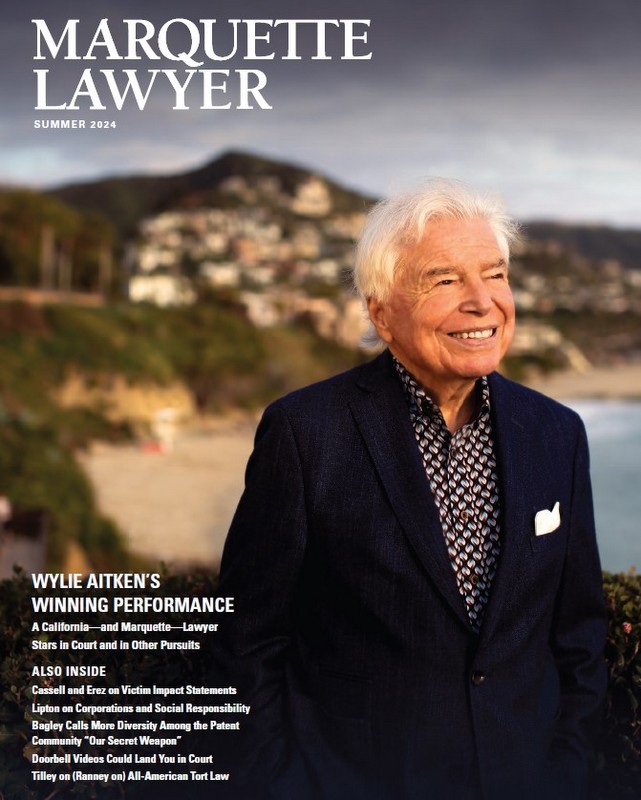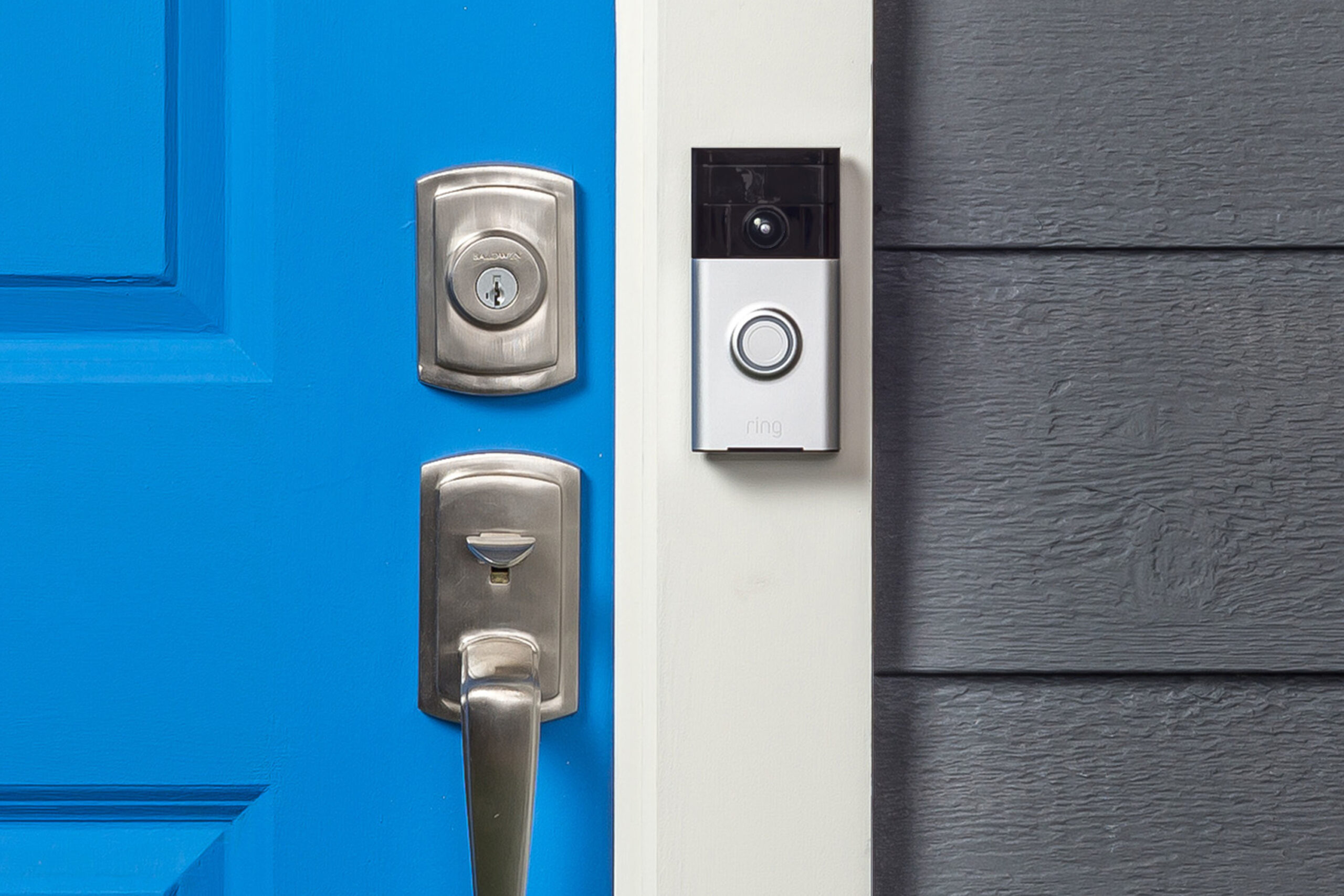We were sitting in my sister’s backyard—my 85-year-old dad in his wheelchair and I in a lawn chair—under the bright afternoon sun. The temperature reached 88 degrees in West Bend, a city of 32,000 about 40 miles northwest of Milwaukee, in the conservative Wisconsin county (Washington) where I grew up.
My dad (Jim) and I, both lovers of hot summers, had been chatting for about an hour when we were startled by the arrival of a police officer. The officer had knocked at the front door and was directed to the backyard by my sister. Here’s how I recall the exchange:
“Is that your car parked out front?”
“Yes.”
“Do you know why I’m here?”
“No.”
The officer pulled out her phone and showed me a one-second video of my car doing a rolling stop at a stop sign. Moments later, she wrote me a $98.80 ticket. Questions arose, some immediately:
How was the video recorded?
How did the police get it?
Had the officer driven around West Bend looking for me?
And, quickly enough, other questions, of a more big-picture sort:
Just how much are law enforcement agencies using video—public and private—
to enforce laws?
And what about privacy rights?
Let’s get at some of these.
“There are Ring cameras everywhere,” said Mary Triggiano, former chief judge of the Milwaukee County Circuit Court and now a clinical professor of law at Marquette University Law School. “Judges are letting in recordings, so long as they’re
authenticated and relevant.”
Triggiano was referring to the most widely known brand of doorbell cameras, now owned by Amazon. Ring doorbells are in such wide use — reportedly 10 million users in the United States, though the company won’t discuss numbers — that the name itself is colloquially identified with the whole field.
The admissibility of the recordings notwithstanding, there are concerns about how video from the cameras is used.
“The question is, where do you draw the line?” said Deja Vishny, formerly an adjunct professor at Marquette Law School and a Milwaukee criminal defense attorney who received the 2023 Champion of Justice Award from the National Association
of Criminal Defense Lawyers. “One of the difficulties is if this invasion of privacy was only restricted to catching criminals, that would be one thing. But what is meant by being criminal? Is it smoking marijuana, which is legal in so many other states?
Is it getting a ride to get an abortion? The problem is, once you have this lack of privacy, the line can keep moving, and it can entrap all types of conduct—which is a reason why we have the Fourth Amendment.”

This story first appeared in the Summer 2024 edition of Marquette Lawyer. The interactive e-magazine and all stories are available on the Marquette University Law School website.
Video use pervasive
Most everyone I told about my case was taken aback to hear that I received a traffic ticket based on a homeowner’s video. But thousands of law enforcement agencies in the United States use video cameras for surveillance.
According to a project of the Electronic Frontier Foundation, a San Francisco-based nonprofit digital rights group, and the Reynolds School of Journalism at the University of Nevada, Reno, as of early 2024:
- 2,530 law enforcement agencies, including 73 in Wisconsin, have a partnership with Ring’s Neighbors, a social media platform that encourages people to share footage recorded by their Ring cameras with neighbors and police. (The project stopped tracking Ring data in March 2024.)
- 1,481 law enforcement agencies (39 in Wisconsin) use automated license plate readers. The camera systems, attached to police cars or mounted in public places, capture each passing license plate number and the location, date, and time, as well as a photograph of the vehicle.
- 464 agencies (including 6 in Wisconsin) use a camera registry. The agencies ask residents and businesses to provide information about their security cameras installed on their properties, in effect creating a network that law enforcement
can tap. - 147 agencies across the country have crime centers that enable analysis of surveillance and intelligence data in real time.
- And there are 79 “fusion centers” around the United States (two in Wisconsin), which are aimed at allowing federal, state, and local law enforcement agencies to collaborate and share intelligence on security and criminal matters.
“We’re concerned about the growing network of cameras trained on our public and private spaces,” said Timothy Muth, an attorney with the American Civil Liberties Union of Wisconsin.
“People always talk about the rights of the business owner with their cameras or the property owner who has the Ring doorbell,” he said. “But I’m more concerned about the rights of the person who is unaware that they are being recorded; they aren’t getting notice in Wisconsin. But it’s a nationwide problem. We’ve really fallen down in failing to put together systems of regulation and control over how information like that is collected and stored and used by law enforcement.”
My ticket
The officer, after saying hello to my dad and me, got right to business. The video clip showed my white Tesla coming to a partial stop at a stop sign. You could see the rear license plate but not the driver.
The young officer, polite and professional, explained that the video had come from a resident at that intersection, which I later learned is three and a half blocks from my sister’s house. The officer said that the resident had repeatedly complained to
police about stop-sign violations outside his home.
That apparently meant the man had viewed, downloaded, edited, and shared the video with police in less than an hour. How long, I wondered, had the officer driven around West Bend looking for my car? Some might view it a huge waste of police time. But, having grown up in a town even smaller than West Bend, I can see the value in trying to
prevent accidents.
The officer said the man told her he had seen my car failing to stop at that stop sign a number of times. I had to interject there. I drive to West Bend every week to see my dad, but, in fact, I took a different route that day from my usual one. So it was a fluke that I had ended up at that particular intersection.
I figured that the resident’s misinformation worked against me. I wondered, too, about my not being a local resident (I live in Milwaukee County) and my driving what is perceived as a fancy car. Plus, police feel pressure to be responsive to a
resident who complains.
“There is no constitutional right to privacy against a search by a private citizen, unless they are acting as an arm of the police,” said Vishny. “Generally speaking, the Fourth Amendment does not protect people from the actions of private actors.”
The officer went to her squad car to run my driver’s license, which gave me a moment to think. I decided I’d use my phone to record the rest of our conversation.
I told the officer that although the video showed “I was rolling,” I thought she should give me a warning. I hadn’t been reckless or speeding, and my driving record is good.
“My main concern is kids. Okay?” the officer said. “There are a lot of kids in that area.”
“I totally understand that,” I agreed. “And I guess, sort of big picture, if it was flagrant or something crazy, or if I had a record . . . . But if the goal is to get the person’s attention and drive home the point of, ‘Hey, that’s a trouble intersection and safety is important,’ I think a warning does that.”
“I get it,” she responded, “but unfortunately, it’s this route today.”
She handed me the $98.80 citation for failure to stop at a stop sign, a violation of section 7.01 of the West Bend Municipal Code, adopting section 346.46(1) of the Wisconsin Statutes. That meant that the fine would go to the municipality paying the officer’s salary and operating the court. The citation also carried a 3-point penalty. In Wisconsin, drivers with a clean driving record have 0 points; license suspension occurs if a driver accumulates 12 or more points within a 12-month period.
Beryl Lipton, an investigative researcher at the Electronic Frontier Foundation, whose specialties include law enforcement surveillance technology, said using video surveillance affects how citizens perceive behavior. “If you have a camera, if you’re constantly checking, well now every single time somebody walks by your house, it feels a little suspicious,” she said.
“And there have been studies on Ring and the types of complaints that it generates,” Lipton continued, “that suggest that people are more likely to start reporting people if they see them on a Ring camera. And in a lot of those cases, the suspicious behavior is not actually suspicious behavior. . . . It generates and reinforces a culture where neighbors and communities are suspicious of the people who are going by.”
A review in the January 2023 Annual Review of Criminology concluded: “Despite their ubiquity, the empirical evidence base for surveillance technologies is weak. For most technologies, even basic information about how many departments use them or how they are deployed is lacking. Even less accessible is good information about surveillance technology’s financial and privacy costs, its impact on police–community relations, and its value in detecting and deterring crime.”
Video also alters how police prioritize cases, Lipton said: “There are serious crimes out there that need to be solved. And if the police are responding to the squeakiest wheel complaining about relatively innocuous traffic violations, then that is expensive police time and taxpayer money that is now going into feeding surveillance subscriptions, and also policing these misdemeanors that in a lot of cases would get thrown out if there
weren’t a neighbor out there” with a camera making complaints to police.
“Ring” video
Ring cameras are sold to individuals and commercial users. For those who also pay for a Ring subscription, video recordings from the cameras, like the one the West Bend resident used, can be stored in the Cloud for up to 180 days, Amazon says. Subscribers can also post video to Ring’s Neighbors app, in an effort to warn fellow app users, residents of the same neighborhood, about crime or events such as road closures and to share video with police and others; local police also have been able to post to the app to alert residents about crime activity or to seek information. The app allows users to see shared videos based on their address, so they can be alerted to happenings nearby. In Wisconsin, even police departments in communities with only several thousand residents, such as the Milwaukee suburb of Saukville in Ozaukee County, use the Neighbors app, according to the Electronic Frontier Foundation database. Police departments in suburban Indianapolis, Indiana, and Raleigh, North Carolina, ask residents to register their cameras, to make it easier for investigators to seek out video.
Scientific American reported in December 2023 that it had found little evidence that cameras by Ring, or from vendors such as Google Nest, Skybell, ADT, or Vivint, prevent or deter crime. At the same time, countless anecdotes show how cameras can help solve burglaries and investigate other incidents. Here are a few examples from news reports in early 2024:
- Private surveillance video showed that a private company ambulance dispatched following a 911 call in Milwaukee drove past an intersection twice, without the crew’s stopping to get out and look around for a woman who had called 911 before losing consciousness. The 49-year-old woman died of high blood pressure and heart disease, according to the Milwaukee County medical examiner.
- A Ring home camera recorded a “porch pirate,” who was a child, perhaps five years old, walking with an adult and taking a package left outside of a home in Miami, Florida. The homeowner posted the video to social media.
- An Atlanta resident received notification from his Ring camera that two men had entered his house; when he went there, he discovered several items missing and alerted police.
In January, Ring stopped allowing police to use its Neighbors app, in order to request video directly from users; the change came after privacy advocates raised concerns about the spread of surveillance. In emergencies, such as a kidnapping in progress,
police can request an individual’s video directly from Ring.
Police can still view video that residents post to the Neighbors app, and police can still get warrants or subpoenas to obtain video from Ring.
Fighting the ticket
Back in West Bend, I eventually learned that a 41-year-old man with kids had used a
camera on his house to record me. The resident messaged police on Facebook, which led to the officer’s being dispatched to his home, according to the police report. The man told the officer about frequent problems at the four-way-stop intersection where he lives. He said he saw me fail to stop and showed the officer video from a
camera he has on his house. She showed me the clip on her phone.
I had assumed the officer had spent some time driving around the neighborhood looking for my car. But the man told police he had followed me to my sister’s house.
I decided I would fight the ticket — not to claim that I had made a complete stop, but to raise questions about the use of video. So I went to MidMoraine Municipal Court online and pleaded not guilty. The automated response said my “court date” would be Aug. 3, about five weeks later. That’s when things got confusing.
Several days after that, the court emailed a pretrial notice, saying that I should make my case in an email to the city attorney, who acts as the prosecutor, and that many cases can be resolved by email. But the notice said to do so no earlier than Aug. 21, 2023; that would be nearly three weeks after my court date.
The next email came from a local private-practice attorney who serves as prosecutor for West Bend and other municipalities in the counties of Ozaukee and Washington. He explained that my Aug. 3 court date” was actually my initial appearance and that entering my plea meant I didn’t have to be in court that day.
Two days after I was allowed to, I made my case to the lawyer in an email, reiterating what I had told the officer: a warning would have sufficed. I asked for the citation to be dismissed or to be reduced to an offense that carried no points. We exchanged a
couple of more emails.
The municipality’s lawyer suggested “amend to a two-point citation for obstructing traffic by slow speed—driving too slowly.”
“How about amending to a citation that has no points?” I countered, knowing that would still give them a conviction and the fine.
“No, sir,” the lawyer’s response came back.
A trial date was set for more than four months after the citation was issued.
The trial
My trial was scheduled for 2 p.m. on Nov. 9 at West Bend City Hall. I represented myself. The municipal judge, a clerk, the prosecutor, the officer, the resident, and I had all arrived by 1:45, so we started early. I declined to speak until my closing argument, which came after opening and closing statements by the municipality’s prosecutor and
testimony from the officer and the resident. The resident testified that he had observed my rolling stop and that it was recorded by the camera on his house. His video was played.
So, too, was something that perhaps I should have anticipated but that surprised me: footage from the officer’s body camera. Body cameras are used by law enforcement agencies even more than Ring cameras. More than 4,500 agencies, including nearly
300 in Wisconsin, have their officers use them. This footage showed me saying that I guessed I was rolling at the stop sign.
After reiterating my belief that I hadn’t been driving recklessly, and the fact that I had a clean driving record, I addressed the use of the resident’s video, alluding to Wisconsin law that prohibits police departments from using “photo radar” for writing speeding tickets.
“. . . I’m just raising concerns about the use of video,” I said. “My understanding is it’s not allowed in Wisconsin for police to use red-light cameras. But in this case, video is used for my citation, and it feels inconsistent.”
“The person who owns and operates the video is here today,” the judge began. “I’m not aware of any limitation that it cannot be used if proper foundation was laid, which it was, and somebody can identify the video, which it was. . . . Quite frankly, Mr. Kertscher, Ring video is everywhere; everybody’s got Ring video these days. It’s not unusual for this court to not only review bodycam, which was admitted into evidence, but people have
evidence on their Ring videos presented in court with the proper foundation.”
“Quite frankly, Mr. Kertscher, Ring video is
everywhere; everybody’s got Ring video these
days.”
The judge rejected my request to dismiss the citation. I told the judge I had learned my lesson, that safety is important, and I asked that those points be considered in any penalty given.
“Mr. Kertscher, this doesn’t make you a bad person,” the judge intoned. “People make mistakes all the time. But the question before me is whether or not you failed to stop at a stop sign, and I am finding you guilty of that question today.”
The ACLU’s Timothy Muth agreed that the police and the court followed proper procedures in handling my case. But Muth expressed privacy concerns. Based on the surveillance methods currently available, it would be possible to track a person driving across the country. And with cell phone tracking devices, it is possible to track passengers in that vehicle. So-called cell-site simulators—devices that “masquerade as legitimate cellphone towers” to surveil cell phones, according to the Electronic Frontier Foundation—are used by more than 70 law enforcement agencies, including the Milwaukee Police Department and the state Department of Justice in Waukesha, one county to the west.
“I think if people came to understand that it’s almost as if the police were installing tracking devices on everyone’s cars, that’s almost what can be accomplished,” Muth said. “That’s the brave new world of surveillance that we’re heading toward, where we do not yet have a system of transparency about what’s being done, about who has access to these unregulated databases.”
“What’s very problematic is that Ring cameras and other devices collect a lot of data on people, and, a lot of times, they [police] are accessing data without a search warrant,” said Vishny. “Here’s an example: Police suspect drug dealing on the street, so they
obtain footage from a Ring camera for the entire day. What they are requesting can be anything—from burglary, speeding, domestic violence, kids being kids giving rise to noise complaints, and complaints from racist neighbors who don’t like Black or
LatinX kids.”
Vishny concluded. “I think there are really profound issues. People are very worried about the surveillance state. . . .The issues are serious and important.”
Tom Kertscher is a freelance journalist who reported for the Milwaukee Journal Sentinel for many years and whose work has appeared previously in Marquette Lawyer.



